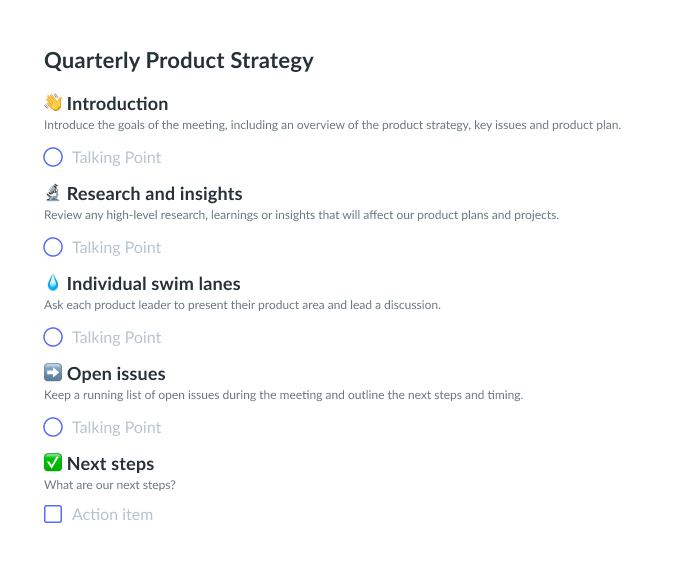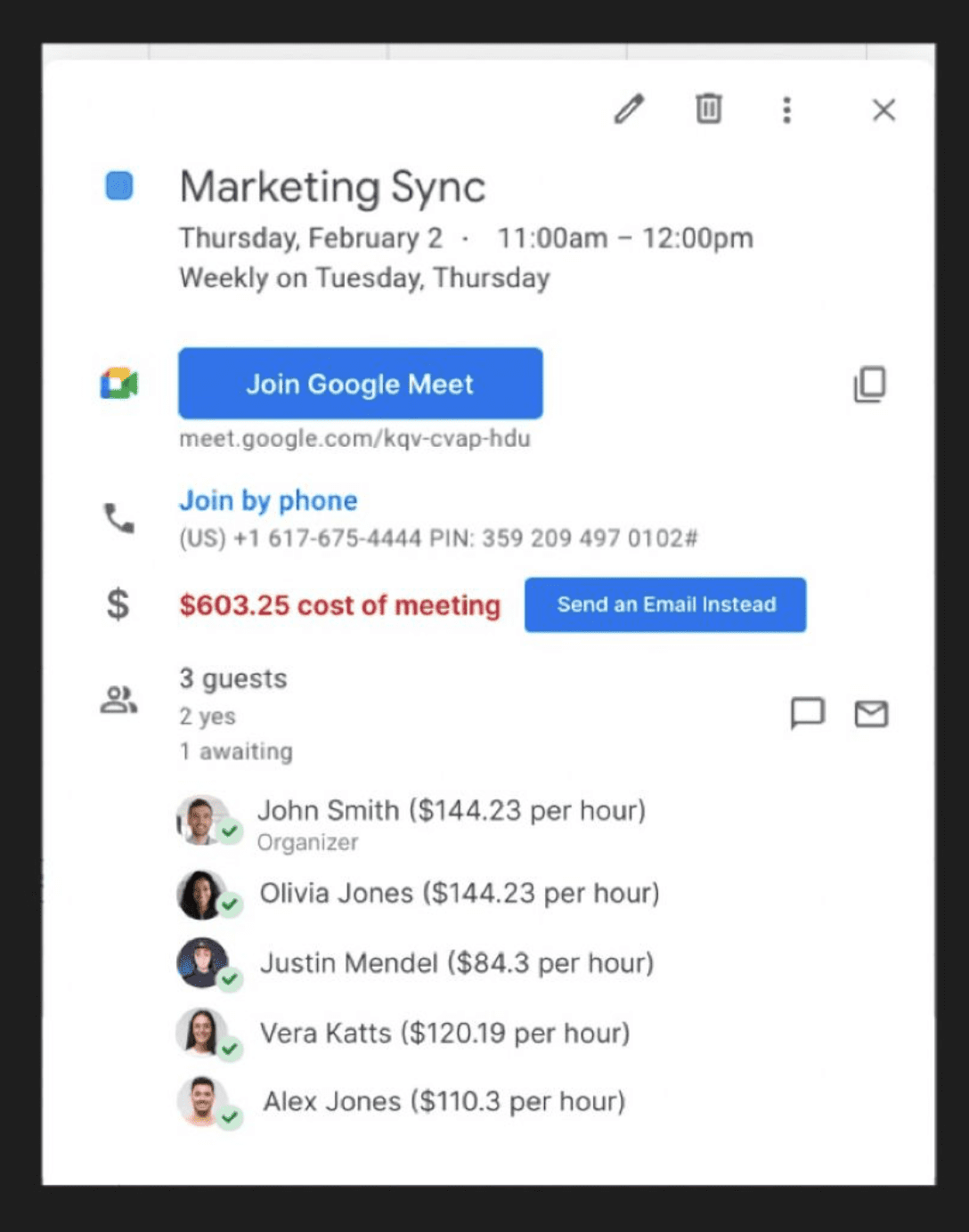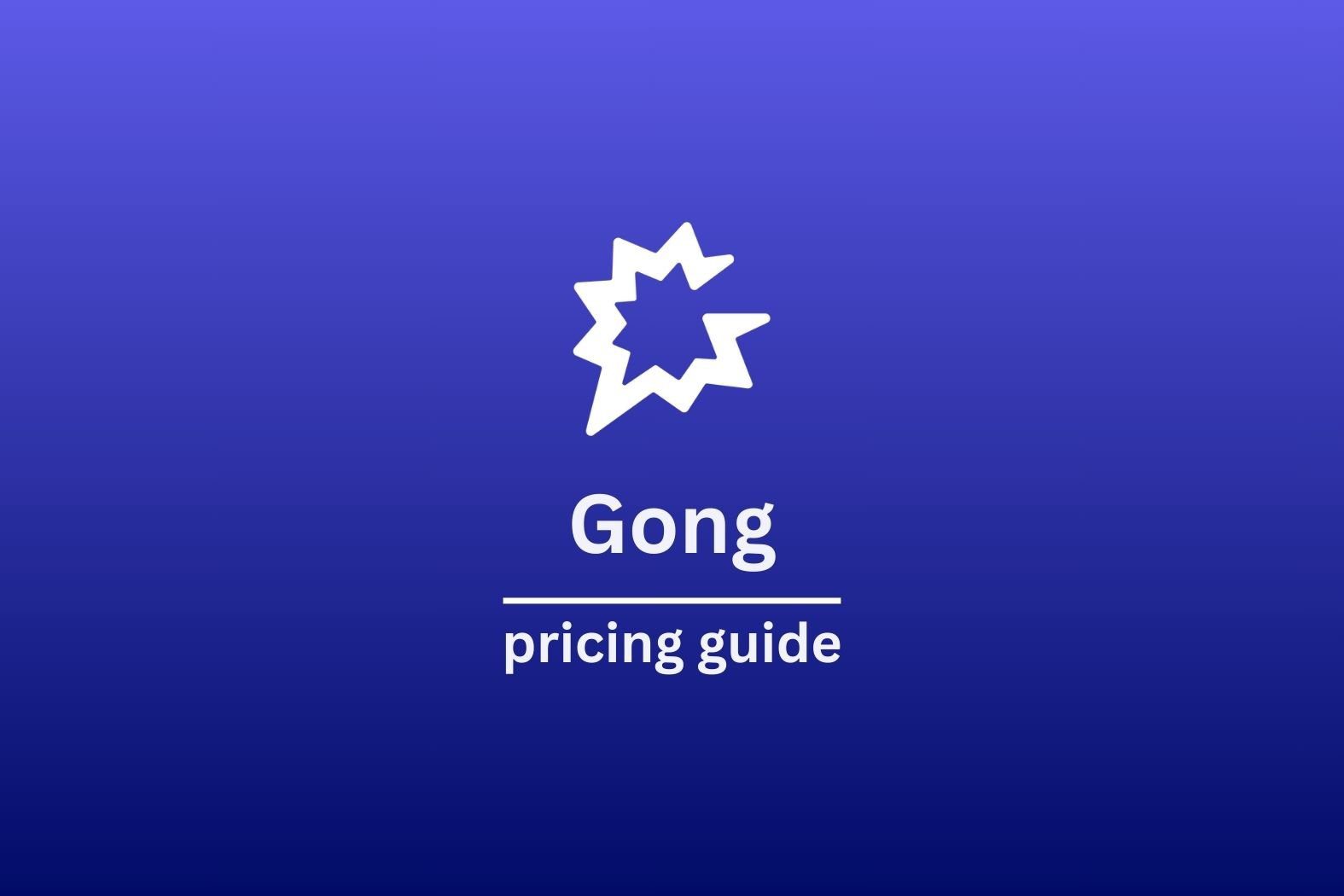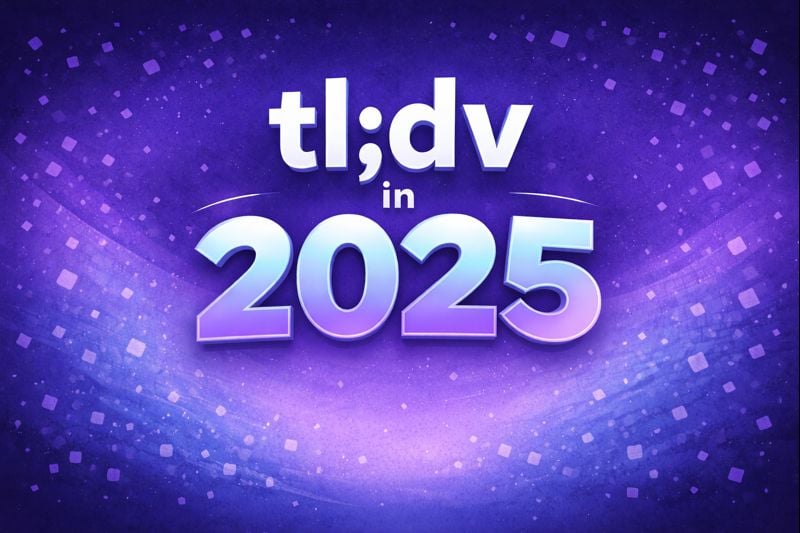Jeder, der schon einmal an Produktentwicklungssitzungen teilgenommen hat, möchte sie in gewisser Weise verbessern. Oder sie gänzlich abschaffen.
Wir können es Ihnen nicht verdenken. Produktmanagement-Sitzungen sind oft lang, langweilig, unorganisiert und ineffektiv. Im schlimmsten Fall rauben sie Ihnen Zeit und Energie, lassen Sie verwirrt zurück und machen Sie weniger produktiv und kreativ als zu Beginn der Sitzung.
Das gilt aber nur, wenn sie schlecht gemacht sind. Es gibt Möglichkeiten, Ihre Produktentwicklungsbesprechungen aufzupeppen, so dass Sie mit einem guten Gefühl und voller Tatendrang aus ihnen hervorgehen.
Bevor wir uns mit den Tipps zur Verbesserung Ihrer Produktentwicklungsbesprechungen befassen, sollten wir einen Blick darauf werfen, welche Besprechungen Produktmanager in ihrem vollen Terminkalender tatsächlich haben.
@tldv.io Das macht absolut Sinn. #Meeting #Komödie #Unternehmen #Meetings #9to5 #firstday
♬ Originalton - tldv.io - KI-Meeting-Recorder
3 übliche Produktentwicklungsmeetings für Produktmanager
Produktmanager haben in der Regel viele Sitzungen. Zu viele. Um sie effizienter zu gestalten, ist es gut, eine Agenda oder Vorlage für Produktentwicklungsbesprechungen zu haben, die Sie als Krücke für Ihre Besprechungen verwenden können. So können Sie den Überblick behalten und Ihre Zeit viel effektiver nutzen.
Hier sind die 3 häufigsten Produktentwicklungsbesprechungen, an denen ein Produktmanager teilnehmen muss und die er in der Regel auch leitet. Sicherlich gibt es noch weitere Besprechungen mit Stakeholdern, der Geschäftsleitung und für andere Kleinigkeiten oder vielleicht mit Beratungsdiensten für das Produktmanagement, aber diese drei sind wahrscheinlich die häufigsten und wohl auch die wichtigsten.
1. Produktstrategie-Sitzung
Eine was? Eine Produktstrategie-Sitzung ist eine Sondierungssitzung, in der alle Fragen der Produktstrategie besprochen werden, einschließlich der Überprüfung von Fortschritt und Leistung. In diesen Sitzungen werden auch neue Ziele für das Unternehmen und deren Verwirklichung besprochen.
Wer sollte teilnehmen? Das Produktmanagement, die Unternehmensleitung und die relevanten Interessengruppen leisten alle einen wichtigen Beitrag zu einer Produktstrategiebesprechung.
Wer sollte leiten? Es wird nicht umsonst als Produktstrategie-Meeting bezeichnet. Die Produktmanager sollten hier das Ruder übernehmen, denn das ist ihre Stärke.
Wie oft sollten sie stattfinden? Je nach den Bedürfnissen Ihres Unternehmens vierteljährlich oder halbjährlich.
Wie lange sollten sie dauern? Auch hier hängt es von der Komplexität des Unternehmens und des Produkts ab, aber eine Produktstrategiebesprechung dauert in der Regel mindestens 2 Stunden und erfordert oft mehrere Sitzungen.
Was sollte behandelt werden? Bei einer Produktstrategiebesprechung gibt es mehrere Dinge zu berücksichtigen. Stellen Sie sicher, dass Sie sie alle klar abdecken, damit alle auf derselben Seite stehen (solange sie für Sie und Ihr Unternehmen relevant sind):
- Marktübersicht
- Die Unternehmensvision überdenken
- Fortschritte bei den aktuellen Zielen, einschließlich neuer Funktionen oder Veröffentlichungen
- Leistungskennzahlen mit Finanzdaten enthalten
- Roadmaps, künftige Ziele und Investitionsbereiche
- Die Bedürfnisse und Hürden des Unternehmens
- Entschiedene neue Aktionspunkte und Ziele (oder die Wiederaufnahme der Bemühungen um frühere Ziele)

Quelle: Vorlage für vierteljährliches Produktstrategie-Meeting | Fellow.app
2. Treffen zur Produkteinführung
Ein was? Eine Produkteinführungsbesprechung oder ein Produkt-Kickoff ist eine Besprechung, in der die Veröffentlichung eines neuen Produkts besprochen wird. In diesen Besprechungen, die häufig handlungsorientiert sind, wird genau besprochen, was entwickelt wird, von wem, in welchem Zeitrahmen, wie die Funktionen funktionieren werden und was die nächsten Schritte für alle Beteiligten sind.
Wer sollte teilnehmen? Je nach Umfang der Einführung kann die Teilnahme auf die Produktverantwortlichen und das Management beschränkt sein, oder sie kann auch Interessengruppen und sogar Nutzerforscher einschließen.
Wer sollte die Leitung übernehmen? Der Produktmanager ist derjenige, der das Produkt-Kickoff-Meeting organisiert und leitet,
Wie oft sollten sie erscheinen? Je nach Ihrem Veröffentlichungsplan können sie wöchentlich, zweiwöchentlich oder sogar monatlich stattfinden. Je schneller Sie Fortschritte machen, desto häufiger sollten Sie sich mit Ihren Teamkollegen austauschen.
Wie lange sollten sie dauern? Für Produktfreigabebesprechungen sind 1 bis 2 Stunden ein guter Richtwert.
Was sollte behandelt werden? Hier sind einige Dinge, die in einem Treffen zur Produkteinführung besprochen werden sollten:
- Zielmarkt und seine Bedürfnisse
- Überblick über die Funktionalität der neuen Version: wie sie funktioniert, wie lange sie dauern wird und welche Vorteile sie für Benutzer und Unternehmen bietet
- UX-Walkthroughs
- Feedback, Kritik und Zeit, um Fragen zu stellen
- Eine GTM-Strategie (Go-to-Market), um alle Teammitglieder aufeinander abzustimmen
- Überprüfen Sie Ihre Checkliste für die Produkteinführung (wenn Sie noch keine haben, sehen Sie unten nach)
- Neue Aktionspunkte und klare Ziele
3. Wöchentliche Überprüfung
Eine was? Bei einer wöchentlichen Besprechung kommt das Produktentwicklungsteam zusammen, um die Fortschritte bei der Erreichung der Geschäftsziele zu besprechen und zu überprüfen. Bei dieser Gelegenheit werden alle aufgetretenen Probleme angesprochen.
Wer sollte teilnehmen? Produktmanagement, Projektmanagement, Produktmarketing, Entwickler oder Ingenieure, Vertriebsteams und Nutzerforscher sind häufige Kandidaten. Im Grunde jeder, der mit der Entwicklung des Produkts zu tun hat.
Wer sollte die Leitung übernehmen? Der Produktmanager sollte federführend sein, doch kann dies je nach dem spezifischen Schwerpunkt der jeweiligen Überprüfung variieren.
Wie oft sollten sie stattfinden? Normalerweise sind sie wöchentlich, aber es gibt keine feste Regel. Sie können sie auch zweiwöchentlich durchführen, wenn dies für Ihr Unternehmen sinnvoll ist.
Wie lange sollten sie dauern? Für eine reguläre Überprüfung reicht in der Regel etwa eine Stunde.
Was sollte behandelt werden? Bei wöchentlichen Überprüfungen sollten die folgenden Themen in der Regel angesprochen werden, wenn sie nicht sogar im Mittelpunkt stehen:
- Fortschritte bei der Erreichung der Unternehmensziele
- Überprüfung des Produktfahrplans
- Kürzlich abgeschlossene Arbeiten
- Anstehende Ziele und geplante Arbeiten
- Neues und wichtiges Nutzerfeedback
- Neue Möglichkeiten
- Mögliche Verzögerungen
5 fantastische Tipps zur Verbesserung von Produktentwicklungsbesprechungen
Jetzt kennen Sie die Grundzüge dieser Produktmanagement-Sitzungen. Lassen Sie uns nun schauen, wie wir sie verbessern können, damit Sie effizienter und produktiver arbeiten können.
1. Fragen Sie sich selbst: Brauchen Sie dieses Treffen WIRKLICH?

Wir von tl;dv sind der festen Überzeugung, dass alle Meetings optional sein sollten. Das mag sich für ein unausgerüstetes Team wie ein riesiges Hindernis anhören, aber mit dem richtigen Meeting-Recorder können Sie alle wichtigen Dinge in Sekundenschnelle aufzeichnen und Ihre Energie auf die eigentliche Entwicklung des Produkts konzentrieren, anstatt 40 Stunden pro Woche darüber zu reden.
@tldv.io Wenn die Antwort bereits aufgezeichnet ist, warum fragen Sie mich dann? #workfromhome #corporatehumor #meetingrecordings
♬ Originalton - tldv.io - KI-Meeting-Recorder
Daher sollte die Liste der Sitzungsteilnehmer so kurz wie möglich gehalten werden, so dass nur die Personen anwesend sind, die unbedingt an der Sitzung teilnehmen müssen . Jede der Personen, die teilnehmen müssen, sollte mit einer klaren Erklärung eingeladen werden, warum ihre Anwesenheit notwendig ist.
Fragen Sie sich: Ist ein Treffen wirklich notwendig? Gibt es einen klaren Grund dafür? Und kann dieser Grund nicht auf andere Weise vermittelt werden, z. B. durch eine virtuelle Nachricht oder ein Loom-Video? Denken Sie auch an die Löhne Ihres Teams - vor allem an die, die nicht reden müssen. Sie sitzen da und hören nur halb zu, während sie an etwas Wichtigem arbeiten könnten.

Alle nicht wichtigen Teilnehmer können sich mit der raffinierten Zeitstempel-Funktion vontl;dv auf dem Laufenden halten, oder Sie können einen kurzen reel der Besprechung erstellen und ihn sofort nach Beendigung des Anrufs auf Slack oder im Arbeits-Chat Ihrer Wahl teilen. Sie werden nichts verpassen.
Wagen Sie einen Vertrauensvorschuss und lassen Sie sich auf die asynchrone Natur moderner Meetings ein. Die Menschen arbeiten von überall auf der Welt aus. Respektieren Sie ihre Zeit (und ihre Zeitzonen) und lassen Sie sie später aufholen, wenn sie nicht unbedingt etwas präsentieren müssen. Wenn Sie asynchrone Besprechungen beherrschen, können Sie sich das ständige Hin und Her in Besprechungen sparen und sicher sein, dass Sie ein effektives Produktteam aufrechterhalten können.
Produktmanager müssen nicht nur nicht den ganzen Tag in Meetings sitzen, sondern können auch Anrufe von Nutzerforschern verfolgen, um während der Hochsaison nah am Kunden zu sein. Sie können auch die KI-gestützte Suchfunktion vontl;dv nutzen, um das gewünschte Thema in Sekundenschnelle zu finden.
2. Zusammenfassung und Hervorhebung der Aktionspunkte am Ende einer Sitzung
Es gibt nichts Besseres, um alle auf Kurs zu halten, als Aktionspunkte zu betonen und Ihrem Team am Ende jedes Gesprächs alles kristallklar zu machen. Natürlich werden Sie während der Besprechung alle wichtigen Punkte abdecken, vor allem, wenn Sie eine unserer Vorlagen verwenden, aber es ist wichtig, die wichtigsten Punkte am Ende aufzufrischen.
Ihr Team weiß nach dem Gespräch, was es als Nächstes zu tun hat, und beim nächsten Treffen können Sie mit Zusammenfassungen und Fortschrittsüberprüfungen aller am Ende des vorherigen Treffens aufgeführten Aktionspunkte beginnen.
Um wirklich sicherzustellen, dass jeder Teilnehmer weiß, worauf er sich als Nächstes konzentrieren muss, ist es eine gute Idee, die Besprechung auf transparente und leicht zugängliche Weise zu dokumentieren, z. B. mit tl;dv. Auf diese Weise können nicht nur Nicht-Teilnehmer die wichtigen Teile des Meetings nachlesen, sondern auch die Teilnehmer können sich selbst auffrischen und die Aktionspunkte noch einmal durchgehen, um ihren Fokus zu verjüngen. tl;dv eignet sich hervorragend für Meeting-Zusammenfassungen, da die KI offensichtliche Fragen, Aktionspunkte und Takeaways aufzeigt, während das Timestamper-Tool es jedem ermöglicht, Erkenntnisse aus dem Meeting auch manuell hervorzuheben.
3. Senden Sie eine Zusammenfassung nach der Sitzung
Sie wissen, dass wir am Ende des Gesprächs die Aktionspunkte hervorgehoben haben? Tun Sie das auch nach der Sitzung.
Sie wollen zwar nicht lästig und herablassend werden, aber Sie wollen, dass der Fokus eines jeden Teammitglieds so klar ist wie der Nachthimmel in der Atacama-Wüste. Alle müssen auf derselben Seite stehen und unumstößliche Aktionspunkte haben, auf die sie zurückgreifen können, wenn sie etwas vergessen oder sich verwirrt fühlen.
Wenn jemand noch einmal nachfragen möchte, was er tun soll, oder wenn ein anderer Kollege die Besprechung aus irgendeinem Grund versäumt hat, sollte er auf eine einzige Quelle der Wahrheit zurückgreifen können.
tl;dv, das häufig als UX-Forschungs-Repository für Benutzerinterviews verwendet wird, kann dabei helfen. Nach dem Ende des Meetings können Sie die verschiedenen Zeitstempel - einer davon sind die Aktionspunkte am Ende - zu Highlight-Reels zusammenführen und den kürzeren clip per E-Mail oder Slack an alle senden.
Vorbei sind die Zeiten, in denen die Effizienz von Sitzungen nur in der Sitzung selbst erreicht werden konnte. Senden Sie nach jeder Sitzung eine Zusammenfassung, und es gibt keine Möglichkeit mehr, sich nicht darüber im Klaren zu sein, was die nächsten Aufgaben sind.
4. Sammeln von Feedback und Erkenntnissen nach dem Treffen
Nicht jedem fällt mitten in einer Sitzung der richtige Spruch ein. Manchmal brauchen sie Zeit, um die kreativen Säfte köcheln zu lassen. Wenn Sie Ihre Besprechungsteilnehmer dazu ermutigen, auch nach der Besprechung neue Erkenntnisse zu gewinnen, erhalten Sie ein weitaus besseres Feedback, als wenn Sie die Zeit für Erkenntnisse nur auf die Telefonkonferenz beschränken würden.
Ideen brauchen Zeit, um sich zu formulieren, und nicht jeder ist ein öffentlicher Redner. Lassen Sie Ihre Tür offen für Erkenntnisse nach dem Meeting, und genau das werden Sie bekommen.
5. Des Teufels Advokat spielen
Wenn die Sitzung beginnt, wie eine Versammlung von Ja-Sagern zu klingen, müssen Sie anfangen, den Anwalt des Teufels zu spielen. Es wird nicht sehr effizient sein, wenn es nur Zustimmung gibt. Ideen werden durch Kritik gestärkt.
Selbst wenn Sie eine bestimmte Idee oder ein bestimmtes Ziel voll und ganz unterstützen, versuchen Sie, sich auf die andere Seite des Spektrums zu stellen. Bringen Sie Einwände vor, auch wenn sie dumm klingen. Scheuen Sie sich nicht, die Idee zu vertiefen. Peppen Sie die Sache ein wenig auf.
Wenn Sie nicht hin und wieder den Teufel an die Wand malen, könnte Ihr Team in den Bann der Voreingenommenheit geraten, und das könnte dazu führen, dass jeder mit allem einverstanden ist, weil Sie alle eine vorgefasste Meinung darüber haben, was Ihr Nutzer will und wie Sie es ihm am besten geben können. Wenn Sie dies frühzeitig im Keim ersticken, werden Ihre Produktentwicklungsbesprechungen deutlich an Effektivität gewinnen.
Der Mom-Test ist eine großartige Methode, um Voreingenommenheit in der Nutzerforschung zu vermeiden. Er kann auch für die Präsentation neuer Ideen in Ihrem Team angepasst werden.





